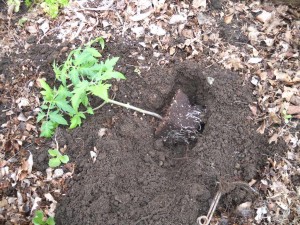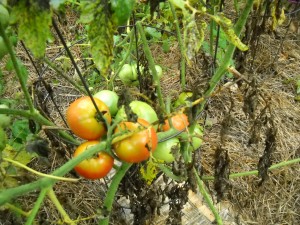Tomatoes
This year I met a lifelong goal of growing an edible tomato in the house, though I have I have to admit that it was quite by accident. Last fall I dug up an avocado plant that had started itself in the compost pile. Mixed in with the soil were seeds that germinated, including a tomato, a pepper and of course, weeds. I let the tomato grow and harvested a ripe tomato on May 10.
The plant has been in a west facing window and, although I did provide some supplemental lighting, that was only for a month or so. I don’t know what kind of tomato it is, but the flavor was excellent – a combination of sweet and tangy.
A few words about “volunteer” tomatoes: I get some in my garden each year, but never let them develop because many are not particularly tasty. Most modern tomatoes are hybrids (Big Boy, Jet Star, Sun Gold are all hybrids). That means that someone figured out that specific crosses of the parents would produce a tomato with desirable characteristics. But seeds from these hybrids will not breed true. Seeds saved from a Big Boy will most likely revert to one of the parents of the fruit, which may not be especially nice. So as you clean up your garden this spring, I recommend that you yank the babies.
What we call heirloom tomatoes do breed true. Tomatoes, unless manipulated for growing seed, are self pollinating. Heirlooms such as Brandywine, Purple Cherokee and Ox Heart will produce seeds that you can save each year and get just what you had the generation before. Heirlooms are not often sold at the grocery store because they are often of irregular size and shape (hard to package) and don’t have the tough skins needed for shipping and handling. But they have amazing flavors.
I grow both heirlooms and hybrids each year – a total, usually of about 30 plants. So why do I grow hybrids if heirlooms are so wonderful to eat? The modern hybrids have been bred for disease resistance, which is important. There are a variety of fungal diseases that can kill the leaves – or even the entire plant, and old fashioned breeding programs have developed tomatoes that resist them.
The worst disease for tomatoes is late blight. If it hits your garden, your tomato plants may well turn into a soggy, blackened mess of inedible fruit and dead plants in just a few days. Late blight also affects potatoes, and was the cause of the Irish potato famine. One hybrid tomato , the Defiant F-1, which was developed by the plant breeders working for Johnny’s Selected Seeds, is listed as “highly resistant” to late blight with “intermediate resistance” to early blight, another pest. I’ve grown it and like it. It has nice medium sized fruit, good flavor, and matures early.
There is much talk about GMO labeling in Vermont right now – they just passed a law that will require processed foods to indicate if there are genetically modified ingredients. As far as I know, there are no GMO tomatoes or other garden vegetables on the market. One GMO tomato was developed in 1994, but the public objected and the market for them was nil.
This year I started my tomato seeds indoors on March 24, three weeks earlier than usual. I transplanted them into bigger pots in early May and they are growing like crazy. But the plants are getting huge, which is a problem: they are too big to fit on my plant stand. I’ve had to remove a shelf so the plants can continue to grow.
If you have long, leggy plants like mine, you’ll need to plant them sideways when the time comes. I will dig a hole for the root ball and then a trench for the long stem. I’ll pinch off all the lower leaves, then cover the root ball and the stem except for the very top cluster of leaves. I‘ll bend the tip of the stem up so that the leaf cluster is above ground level. The plant will straighten itself up in a few days. The long stem will turn into roots. Alternatively, you could plant the rootball deep, burying part of the stem.
Whether you grew your tomatoes from seeds or bought plants at the garden center, it is important to harden-off the plants before they go in the garden. That means introducing them to the sun’s powerful rays and the wind’s drying effects a little each day until the plants are ready to go out in full sun. Put them near the house on the north side so that they get just a few hours of morning sun, then gradually give them more sun. Just like a fair-skinned toddler, plants can burn if they get too much sun. Greenhouses provide a lot of protection. And bring them in on cold nights.
A soil thermometer is a useful item at this time of year. Cold, wet soil is not good for most plants, and tomatoes in particular. Sixty degrees is a good minimum soil temperature to attain before planting.
I don’t plant frost-sensitive plants until well after the last frost, though a few warm days always tempt me. But lettuce, peas and other frost hardy things are going in now. I’m ready for summer!
Henry’s Web site is www.Gardening-guy.com. Contact info is there, along with previous articles and information about his gardening books.
Getting Ready for Spring and Worrying About Tomatoes
I know that most of you have probably already ordered your seeds, but I just did so on the day I wrote this column in the last week of February. I spent a recent Sunday afternoon going through my seeds and throwing out any seeds that were older than those packaged for the 2010 growing season. Almost any seed is viable for 3 years, and some are good even longer. Of course storing seeds in a cool dark place helps prolong viability, too. It hurts me to throw out seeds, but I don’t want to plant and then find that I my seeds didn’t germinate well – or at all.
Many people have e-mailed me with questions about the various blights that have plagued our tomatoes in recent years. What can we do? Well, I hedge my bets. I buy both heirloom seeds (which generally have little resistance to blights and diseases but taste great) and modern hybrids that have been bred to resist diseases. Of the first generation hybrids (called F-1 hybrids in the catalogs) I have had good results with Sungold cherry tomatoes, Defiant, and Mountain Magic. The latter two are available from Johnny’s Selected Seeds. Sungold is available everywhere. All are tasty, but nothing beats the flavor of an heirloom Brandywine.
I also order some seeds for tomatoes that are early to produce. A 60-day tomato is much more likely to survive long enough to produce a good batch of fruit than one that takes 78 days or longer. Those days on the seed packages, by the way, refer to how many days under ideal conditions it should take to get fruit after transplanting seedlings into the ground. If we have a cold, rainy summer a 60-day tomato can take a week longer – or even more.
In responding to a reader who asked about blights, I came up with a plan I shall try myself: creating a simple plastic-covered hoop house for some of my tomatoes. Some diseases have spores that live in the soil, and get on the lower stems and branches by splash-up. If I keep the plants protected from the rain and I water carefully, I should have few of those diseases. Mulching helps, too.
Other diseases are air-borne. Late blight, one of the most virulent diseases, is air-borne. Depending on the prevailing winds and the presence of diseased plants in your neighborhood, you might get it – or you might not. A greenhouse would be a big help keeping out those spores, but greenhouses are expensive. A simple open-ended hoop house should help some, and not cost much. It will be most protective if the open ends are not facing the prevailing winds. So that is what I shall do.
I’ve built hoop greenhouses with windows and doors, and it’s quite a bit of work. So this year I shall try something easier. I will make a 10 ft by 10 ft hoop house big enough to walk through, but without all the carpentry of a door and a window. It should hold 10-12 tomato plants, maybe more.
Here is what is needed: Twelve 10-foot pieces of ¾ inch PVC electrical conduit and some PVC glue. A piece of greenhouse plastic roughly 20 feet by 12 feet. Enough row cover or “Reemay” to drape over the ends, maybe 12 feet by 8 ft (I’m hoping this breathable fabric will keep out spores but allow breezes to pass through). Some carpenter’s spring clamps to hold the plastic and Reemay in place. And two 10-foot pieces of wood strapping that I will screw into the ribs of the hoop house to keep the hoops from moving.
I will pull a string tight between 2 sticks to define one side, and then measure over 10 feet and do it again. My soil is soft, so after I have glued 2 pieces of conduit together, I shall just push the ends in the ground, creating a hoop (the conduit is flexible but sturdy). Measure over 2 feet, repeat. And so on. I will try to buy my greenhouse plastic from a local greenhouse, or see if I can get a used piece they have taken down. Worst case scenario? I’ll buy 4-mil plastic that is not UV protected –but it will only work one year before it decays in the sun.
Once the cover is on, you could use a screw gun to screw right though some strips of wood strapping into the ribs with sheet rock screws to stabilize the structure and help hold the plastic in place. I’ll do it 3 feet off the ground on each side of the hoop house. Carpenter’s spring clamps can be bought for $2 each, and could be used to clamp the Reemay over the ends.
I reckon I can build that hoop house in an afternoon. If you want to have something even smaller, use just 10 feet or 15 feet of conduit per hoop over a 3 or 4 foot wide bed. You won’t be able to walk in it, but it will be even cheaper and easier to build. You’ll have to remove the plastic each time you want to weed, pick or water, of course.
Gardening is a constant challenge. If the blight doesn’t attack, maybe the hornworms will. But I’ll try not to worry too much, and try to figure out what I can do cheaply and efficiently to get the best production possible. Wish me luck!
Henry Homeyer’s Web sites are www.Gardening-Guy.com and www.henryhomeyer.com





